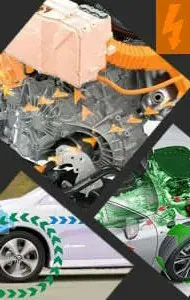Braking Systems in Hybrid & Electric Vehicles

Course Overview
The braking system of electric vehicles is slightly different to that of a conventional vehicle with a combustion engine. They are still equipped with the conventional braking system with callipers and drums moved by hydraulic fluid by means of a master cylinder, but they can also be braked using the electric motor that drives the wheels.
This strategy involves always prioritising braking by means of the electric motor, called regenerative braking, which reduces the speed of the vehicle by acting on the magnetic fields of the stator phases in order to brake the rotor. This braking generates energy that is sent to the battery for storage and does not use the brake pads, so that the brake pads in these vehicles are changed at double or treble the mileage of a conventional vehicle.
The hydraulic brake is used to stop the vehicle completely, something that the regenerative brake cannot do, or braking in which the speed needs to be reduced more quickly and for emergency braking.
The main aims of this course are:
- To distinguish between different techniques used by the manufacturers for compensating energy losses that occur in vehicles with an internal combustion engine during operation.
- To understand the operating principle of energy recovery in hybrid and electric vehicles.
- To analyse the structure, the particular features and how the vacuum is generated in a brake servo of a hybrid or electric vehicle, with details of the electromechanical and hydraulic type brake boosters.
- To determine the functions and composition of the control module and the pressure accumulator in a regenerative braking system.
- To classify the energy recovery levels in accordance with the type of selection in a hybrid or electric vehicle.
- To carry out a study of the electric drive as a current generator for energy conversion.
- To relate the interaction between electric and hydraulic decelerations of regenerative braking.
- To review the operation of braking control in a vehicle with a regenerative braking system.
- To assess the need of an additional power storage system in the regenerative braking system.
- To recognise the different braking assistance functions in a vehicle with recuperative braking.
- To define the necessary devices for measuring and controlling the system.
- To establish the assembly and maintenance processes characteristic of a regenerative braking system.
Course Topics
1.- Structural characteristics of the regenerative braking system
1.1.- Reduction of energy losses
1.2.- Energy recovery in hybrid and electric vehicles
1.3.- Brake servo system
1.4.- Brake servo control unit
1.5.- Pressure accumulator
1.6.- Test of knowledge
2.- Operation of the regenerative braking system
2.1.- Electric drive in the regenerative braking system
2.2.- Energy recovery levels
2.3.- Interaction between electric and hydraulic decelerations
2.4.- Test of knowledge
3.- Brake control system
3.1.- Operating principle
3.2.- Auxiliary battery
3.3.- ABS Systems
3.4.- Test of knowledge
4.- Maintenance
4.1.- Measuring and control equipment
4.2.- Establishment of assembly and maintenance processes
4.3.- Verification and adjustment of the systems
4.4.- Test of knowledge
5.- Self-assessment
5.1.- Self-assessment
Average Duration
3 hours 36 minutes
Access This Course
Get access to this course and 30+ more topics by subscribing.
Subscribe to Access All Online Courses
We provide access to all of our online courses for 12 months with a one-time purchase.
£199 ex.VAT per year

